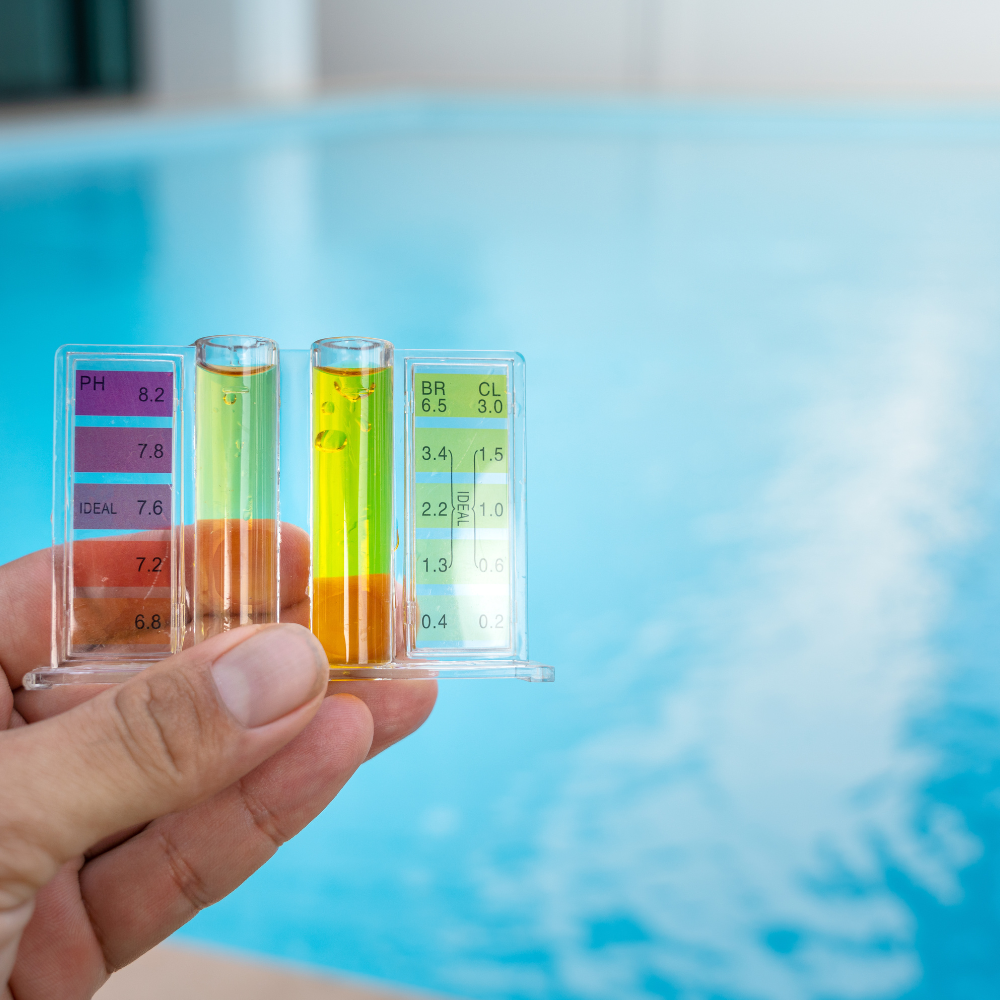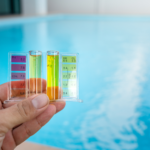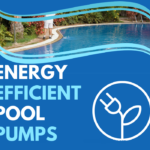
Understanding Chlorine Stabilizers in Pool Maintenance
Chlorine stabilizers play a pivotal role in preserving the cleanliness and safety of pool water. As a pool owner, it’s essential to grasp the workings of these stabilizers, along with their safe and effective application. This section delves into the intricate details of chlorine stabilizers, exploring their definition, role, and functionality in pool maintenance. Whether you’re a novice pool owner seeking to expand your knowledge or a seasoned one aiming to brush up on the basics, this comprehensive guide will arm you with the necessary insights to manage your pool’s hygiene efficiently and safely.
Definition and Role of Chlorine Stabilizers
Chlorine stabilizers, also referred to as Cyanuric Acid (CYA), are chemicals utilized in swimming pools to prolong the lifespan of free chlorine. Think of them as a sunscreen for your pool’s chlorine, shielding it from rapid depletion caused by the sun’s ultraviolet (UV) rays.
These stabilizers perform a crucial function by forming a protective shield around chlorine molecules, enabling them to resist the UV radiation that would otherwise break them down. This process helps to prevent the loss of fchlorine’s sanitizing power in your pool. As a result, the stabilizer ensures your pool stays clean, clear, and free from harmful bacteria, while also reducing the consumption and cost of chlorine. Furthermore, maintaining an appropriate balance of stabilizer in your pool can reduce the need for frequent shocking – a process that involves using large amounts of chlorine to eliminate contaminants.
In essence, this chemical compound serves a dual purpose: it not only conserves your resources by minimizing the need for constant chlorine replenishment but also contributes to the overall health and safety of your pool water. However, as with all chemicals, it’s crucial to use chlorine stabilizers in the right amounts and adhere to safety protocols, which we will explore in the following sections.
Functionality of Chlorine Stabilizers
Chlorine stabilizers act as a protective barrier for your pool, mitigating the rapid dissipation of chlorine due to sunlight exposure. The sun’s ultraviolet (UV) rays can hasten chlorine evaporation, diminishing its sanitizing potency.
This is where chlorine stabilizers, specifically Cyanuric Acid (CYA), step in. CYA forms a temporary, protective bond with chlorine molecules, shielding them from UV radiation’s deteriorating effects. This bond is weak and temporary, allowing chlorine to continue its sanitizing duties unhindered. After the chlorine has neutralized bacteria and algae, it departs, leaving the stabilizer ready to protect another chlorine molecule.
In essence, chlorine stabilizers slow down the rate at which chlorine is lost to sunlight, maintaining a consistent level of active chlorine in the pool to combat bacteria, algae, and other organic matter.
This process ensures the pool water’s chemical composition remains balanced, fostering a clean and healthy environment for swimmers without necessitating excessive chlorine. Stabilized chlorine enables longer swim sessions by optimizing sanitization and minimizing potential health risks associated with chlorine overuse. The subsequent sections will delve into the safe and responsible use of chlorine stabilizers.
Proper Application and Quantity of Chlorine Stabilizers
The appropriate use of chlorine stabilizers in your pool is pivotal to creating a pleasant swimming environment and promoting effective sanitization. This can help prevent common pool issues such as algae infestations or murky water. Mastering the correct application methods and determining the right quantity of stabilizers to use are key to maintaining a clean and healthy pool.
The two crucial aspects to consider are the application process and the quantity. Both are integral to the overall health, safety, and efficiency of your pool. The following sections will provide a comprehensive guide on application techniques and how to ascertain the correct quantity of stabilizers for your pool.
Application Techniques
Effective use of chlorine stabilizers hinges on proper application techniques. These chemicals can be introduced into your pool either directly or through the pool skimmer.
When using the skimmer method, it’s crucial to turn off the pool pump before adding the stabilizer. Pour the prescribed amount into the skimmer, then reactivate your pump. This approach allows for a slow, even distribution of the stabilizer, mitigating the risk of concentrated pockets.
For direct application, it’s advisable to dissolve the stabilizer in a bucket of warm water before adding it to the pool. This step helps prevent the stabilizer from sinking and potentially damaging the pool liner. Once dissolved, slowly pour the solution into the pool, ensuring it disperses evenly.
No matter which method you choose, running your pool pump for several hours post-application is essential. This step ensures thorough mixing and distribution of the stabilizer.
Patience is key after adding the stabilizer. Allow 48 to 72 hours for the stabilizer to balance out before checking the levels again. Premature testing can yield inaccurate results and disrupt your pool’s chlorine balance. The following section will delve into maintaining the correct quantities of chlorine stabilizers.
Determining the Correct Quantity
Maintaining the right concentration of chlorine stabilizers is vital for optimal pool health. The ideal range is typically 30 to 50 parts per million (ppm) of Cyanuric Acid (CYA) in your pool. However, factors such as climate, geographical location, and daily sunlight exposure can affect this amount.
To determine the correct quantity of stabilizer, you can use a chlorine stabilizer calculator or a Cyanuric Acid test kit. Begin by testing your pool’s existing CYA levels with the test kit. If the levels fall below 30 ppm, it’s time to add more stabilizer. Conversely, if the levels exceed 50 ppm, hold off on adding more to avoid diminishing the chlorine’s effectiveness.
A chlorine stabilizer calculator can provide guidance on the amount of stabilizer needed to achieve the ideal CYA concentration. You’ll need to input your pool’s volume, current CYA levels, and target CYA levels to get an accurate estimate.
Always add stabilizers gradually, retesting and adjusting as needed to prevent a sudden spike in levels. Overcompensation can complicate corrective measures and may necessitate draining some or all of your pool water to reduce CYA levels. In the next section, we’ll explore how to manage overuse of chlorine stabilizers.
Handling Overuse of Chlorine Stabilizers
Navigating the repercussions of excessive use of chlorine stabilizers, such as Cyanuric Acid (CYA), is a critical aspect of pool maintenance. An overabundance of CYA can compromise the efficacy of chlorine, leading to sanitation issues. Recognizing the potential consequences of overuse and understanding how to prevent and rectify it is paramount. The following sections will delve into these topics, providing you with the necessary knowledge to manage such situations and maintain an optimal pool environment.
Effects of Overuse
While it may seem beneficial to use an abundance of chlorine stabilizers for pool safety, the reality is that overuse can have detrimental effects on both the pool’s health and the safety of its users. The primary function of stabilizers is to enhance chlorine’s efficiency, but when CYA levels exceed the 50 parts per million (ppm) mark, the effectiveness of your chlorine can be significantly compromised.
Elevated CYA levels can lead to ‘over-stabilization’ of the chlorine in your pool, reducing its ability to effectively eliminate bacteria, viruses, and algae. This can manifest in a variety of problems, such as persistent algae blooms, murky water, and an increased demand for chlorine.
Moreover, the overuse of stabilizers can pose health risks for swimmers. Prolonged exposure in over-stabilized pools can cause skin and eye irritations and respiratory issues. Regular use of such pools may also increase the risk of developing more serious health complications over time. Therefore, it’s crucial to address overuse promptly when detected and take steps to prevent such situations from recurring. The subsequent section will provide guidance on how to prevent and rectify the overuse of chlorine stabilizers.
Preventing and Remedying Overuse
To prevent overuse of chlorine stabilizers, adherence to established pool maintenance protocols is key. Regular water testing is a critical part of these procedures. By consistently monitoring your pool’s CYA levels, you can maintain the right balance of chlorine stabilizer. It’s important to note that not all types of chlorine necessitate the addition of a stabilizer each time they’re used.
In the event of overuse, the most effective solution typically involves draining and diluting your pool water, either partially or fully. This process helps decrease the CYA concentration in your pool, aligning it with the recommended levels. It’s essential to avoid the temptation of simply adding more chlorine to balance high CYA levels, as this could further disrupt your pool’s chemical equilibrium and create additional issues.
For severe cases, you may opt to use a CYA reducer, a product specifically formulated to decrease CYA levels without the need for draining the pool. However, the effectiveness of these reducers can vary, and their frequent use can prove expensive. As such, it’s generally more cost-effective and reliable to address overuse by replacing pool water.
If you’re uncertain about managing these chemical imbalances, don’t hesitate to seek professional assistance. The correct usage and monitoring of stabilizers demand a certain degree of technical expertise, which pool maintenance professionals can provide. The advantages of such professional services will be discussed in subsequent sections.
Safety in Storing and Handling Chlorine Stabilizers
Understanding how to safely store and handle chlorine stabilizers is a vital aspect of maintaining a secure and healthy pool environment. Given their chemical nature, these substances necessitate careful handling and secure storage to prevent potential hazards and accidents. In the following sections, we’ll explore the recommended practices for managing these chemicals and the protocols for storing them safely. This information will contribute to the overall health of your pool and ensure the safety of those involved in its upkeep.
Safe Handling Practices
Exercising care and precision is paramount when dealing with pool chemicals, including chlorine stabilizers. Although generally safe, mishandling can present potential hazards.
Before interacting with these stabilizers, it’s crucial to don personal protective equipment (PPE) such as goggles, gloves, sturdy footwear, and, if necessary, a respirator. This protective gear minimizes the risk of accidental chemical contact that could cause skin or eye irritation.
Ensure that the area where you handle the stabilizers is well-ventilated to prevent inhalation of chemical dust. If you must work in an enclosed space, take steps to prevent dust circulation.
Mixing stabilizers with other pool chemicals, particularly chlorinated compounds, is a strict no-no. Such combinations can trigger dangerous reactions, including combustion.
To prevent cross-contamination and ensure accurate dosages, use clean, dedicated measuring equipment. A clean, dry scoop or similar utensil should be used each time. Combining different chemicals in the same container could result in harmful reactions and contamination.
Lastly, always adhere to the manufacturer’s instructions on the packaging. These guidelines provide vital information about handling, potential hazards, correct dosing levels, and emergency procedures in case of accidental exposure.
Following these safety measures not only safeguards the handler but also preserves the pool’s chemical balance. Let’s now transition to the storage guidelines for chlorine stabilizers.
Guidelines for Storage
Storing pool chemicals like chlorine stabilizers correctly is as important as handling them safely. Improper storage can result in chemical degradation, dangerous reactions, or unintended exposure.
Store your chlorine stabilizers in a cool, well-ventilated, and dry area away from direct sunlight. Heat or sunlight exposure can compromise the stabilizer’s effectiveness.
Retain these chemicals in their original containers, which are specifically designed to maintain the chemical’s integrity and provide important safety information. If you must transfer the stabilizer to another container, ensure it’s resistant to chemicals, clearly labelled, and dedicated solely to that stabilizer.
Keep stabilizers and other pool chemicals separate from flammable substances and materials that react with chlorine, such as gasoline, fertilizers, or oily rags. Store them off the ground on sturdy shelves to avoid accidental disturbances or spills and keep them out of children and pets’ reach.
Avoid cross-contamination by keeping chlorine stabilizers separate from other pool chemicals. Contact between different chemicals can trigger dangerous reactions.
Lastly, secure your storage area to prevent unauthorized access. A lockable cabinet or a dedicated outdoor storage shed can serve this purpose well.
By adhering to these storage guidelines, you can ensure the safekeeping of chlorine stabilizers and contribute to a safer pool environment. In the following section, we’ll explore the advantages of professional pool maintenance services.
Professional Pool Maintenance and Chlorine Stabilizers
Even the most hands-on pool owners can benefit from the expertise of a professional pool service provider when it comes to managing chlorine stabilizer levels. The specialized knowledge and skills of these professionals can significantly enhance your pool care routine, ensuring that all safety measures are meticulously implemented. In the following sections, we will delve into the numerous benefits of hiring professional services for pool maintenance and provide guidance on selecting a trustworthy provider.
Advantages of Professional Services
The decision to engage professional pool maintenance services can bring a wealth of benefits, particularly in relation to the effective use of chlorine stabilizers.
Professionals in this field bring to the table a wealth of knowledge and experience. They understand the complexities of pool chemistry and know exactly when and how to use chlorine stabilizers to achieve optimal results. Their expertise extends to identifying and rectifying common pool issues, such as algae growth, chemical imbalances, and mechanical malfunctions.
Another significant benefit is the regular testing and adjustment of your pool’s water chemistry. This routine monitoring ensures optimal sanitation and pH levels, eliminating guesswork, preventing overuse of stabilizers, and enhancing the effectiveness of chlorine.
Safety is another area where professionals excel. They adhere to strict safety protocols for handling and storing chemicals, minimizing the risk of accidents or misuse. The use of professional-grade tools and equipment further enhances safety and efficiency during pool maintenance tasks.
In addition to safeguarding your pool, professional services can also save you valuable time. The tasks of regular testing, adjusting, cleaning, and repair can be time-consuming for pool owners but are handled efficiently by professionals.
Lastly, professional services often provide comprehensive reports on your pool’s health. These reports offer an easy-to-understand snapshot of your pool chemistry and maintenance tasks, giving you peace of mind that your pool’s health and safety are in expert hands. In the next section, we will discuss how to choose a reliable pool maintenance service provider.
Choosing a Reliable Pool Maintenance Service
When it comes to entrusting the care of your cherished swimming pool to a maintenance service, the decision should be well-thought-out and informed. There are several key factors to weigh in this process to ensure you’re aligning with a proficient provider.
Begin by examining the service provider’s experience and credentials. Have they been in the pool maintenance industry for a substantial period? Do they hold any professional certifications? A history of successful pool maintenance projects is a strong indicator of reliability and expertise.
Next, consider the breadth of services they offer. A provider that can handle tasks ranging from water testing and chemical management to repair services can serve as a comprehensive solution for all your pool maintenance requirements.
Don’t hesitate to delve into references and reviews from previous clients. These can offer insights into the provider’s service quality, customer experience, and responsiveness. Feel free to request references from the service provider themselves.
It’s also crucial to have a clear understanding of what the service contract entails. Ensure that the agreement encompasses all necessary tasks and clearly states the frequency of services.
A top-tier service provider will always place customer service at the forefront. Assess their speed in responding to inquiries, their readiness to address your concerns, and their overall professionalism.
Finally, take into account the cost of the service. While it might be tempting to opt for the cheapest option, remember that the best value often lies in a balance between cost and service quality.
By investing time in this thorough evaluation process, you can confidently choose a pool maintenance service that is not only reliable but also tailored to your unique needs and circumstances.




